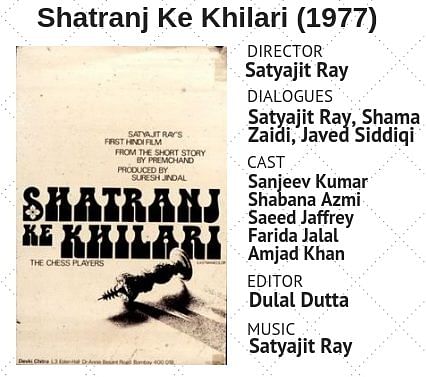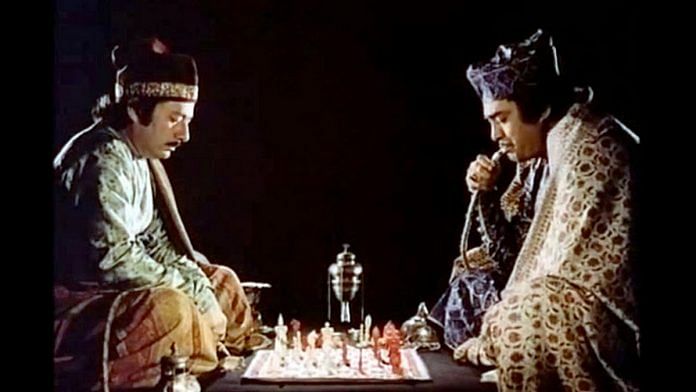There are few films in Bollywood that have truly stood the test of time. And while there are many cult classics from each decade of cinema, there are only a handful of films that are timeless. Cine maestro Satyajit Ray’s first Hindi film, Shatranj Ke Khilari, released in 1977 falls in that category.
 Ray, whose 27th death anniversary was last week, gave us a film that rings true in all political climates and societies – whether feudalist or democratic. Shatranj Ke Khiladi keeps reminding us that in our daily petty politics, we miss the wood for the trees. Something to think about while we vote in the 2019 Lok Sabha elections.
Ray, whose 27th death anniversary was last week, gave us a film that rings true in all political climates and societies – whether feudalist or democratic. Shatranj Ke Khiladi keeps reminding us that in our daily petty politics, we miss the wood for the trees. Something to think about while we vote in the 2019 Lok Sabha elections.
Based on Munshi Premchand’s short story of the same name, the film is set in Lucknow, Awadh in 1856, when the East India Company was aggressively colonising the country. Nawab Wajid Ali Shah rules the land, but is more interested in the arts than in governance and statesmanship. In his kingdom live two noblemen, addicted to the game of chess. They’re so taken by the game of strategy that they’re completely oblivious to bigger things happening in their own lives — unhappy wives and their city being taken over by the British.
Also read: Satyajit Ray: Cine maestro & literary genius who could say no to Indira Gandhi, Narasimha Rao
The two noblemen Mirza Sajjid Ali and Mir Roshan Ali, played beautifully by Sanjeev Kumar and Syed Jaffrey, are consumed with thinking up new strategies for the chess board, while the British are using similar strategies to take over their homes, right under their noses.
The film, made during Indira Gandhi’s Emergency period, poses difficult political questions: Can the nobility indulge in the arts while there is a financial and political crisis in their kingdom? Can art and craft be redeeming factors when all else is lost? Should we feel sympathetic for the kohl-eyed Nawab losing his kingdom? And would that be nationalistic?
All of Premchand’s stories have one thing in common — revealing the innermost, the ugliest, and the most interesting parts of human nature. Perhaps that is why Satyajit Ray was so taken by the story — he does the same with his films. He expertly juxtaposes the noblemen struggling to play their game of chess in peace, with the game that the Governor General of British India (Richard Attenborough) plays with the Shah (Amjad Khan) for his kingdom. There are no heroes or villains in the film. The story of either is not black and white, and the grey tones are shown in subtle yet perfectly dramatic light, matching the colour-schemes and the simple aesthetics of the cinematography. Shatranj Ke Khilari was Satyajit Ray’s most expensive film.
Satyajit Ray is not called one of the greatest filmmakers of the 20th century simply for beautiful films. His use of space and silences is so masterful that a viewer (even an impatient one in 2019) is hooked from the start, oblivious to the what might otherwise be considered “long, boring stretches of film”. His attention to detail — right from the hand gestures and accents to the clothes and sets — is remarkable and transports you to the era. Producer Suresh Jindal, in fact, wrote about this in his book, My Adventures with Satyajit Ray: The Making of Shatranj Ke Khilari. He explains the painstakingly long process of research and scouting that Satyajit Ray undertook to get this film just right. Not being a native Hindi or Urdu speaker, he consulted experts for the right usage and expressions.
Also read: Kissa Kursee Ka: A parody that sent Sanjay Gandhi to jail and laid bare Indian politics
Shabana Azmi, who played Mirza’s wife in the film, told Suresh Jindal how much she valued working for Ray. “When I told Shabana Azmi, a gifted actress with several memorable films to her credit, that her role in Shatranj Ke Khilari would be limited to two or three scenes, she replied: ‘Suresh, if Ray wants me to hold a jhadu for one shot only, I will gladly do it. Work with Ray? Wow!’” he recalled in his book.
As you fume and laugh over the stupidity and ignorance of the protagonists, Satyajit Ray and Premchand’s masterstroke sneaks up on you — that you, dear viewer, are also that chess player. So, absorbed in our daily lives that we barely look up to see the larger picture, be it the people governing us or the way we’re ruining the planet. But once again, we shrug it off and move on to the next round.






